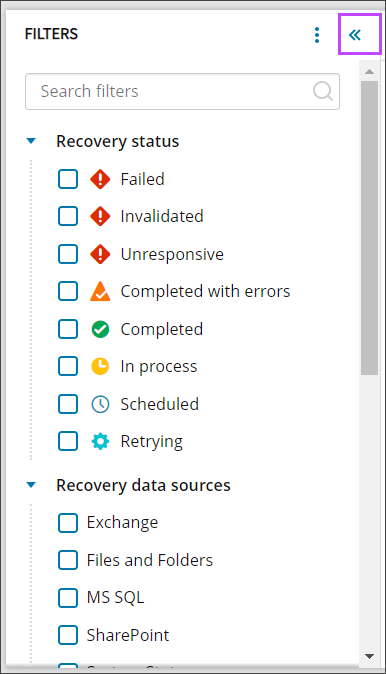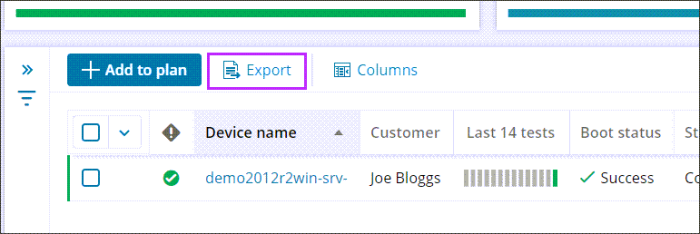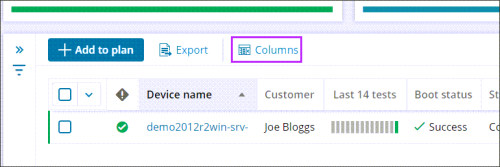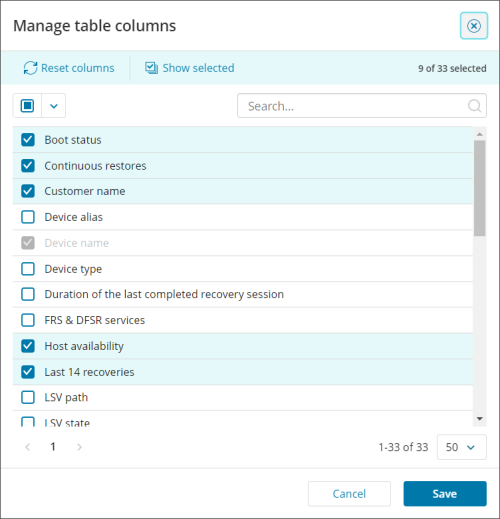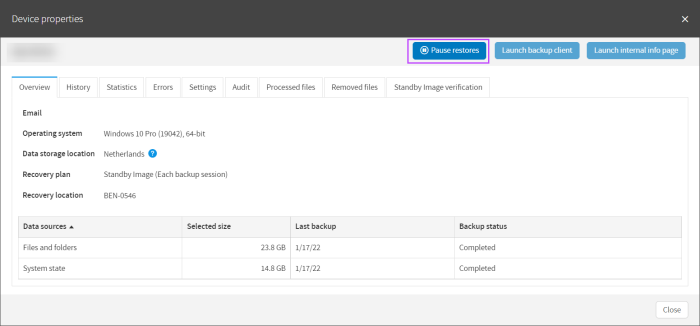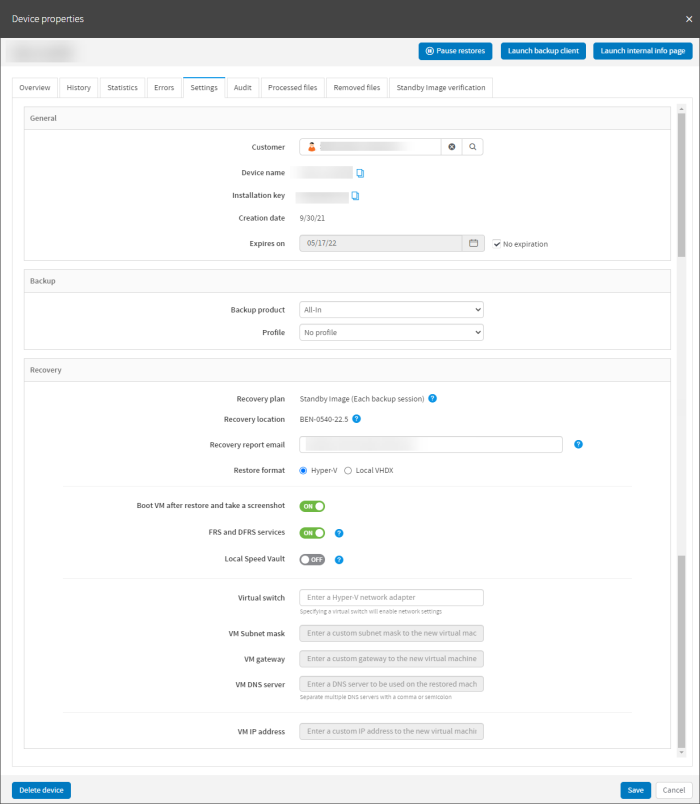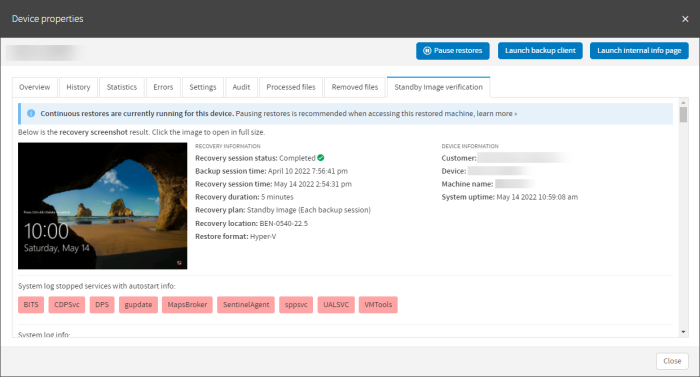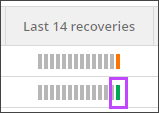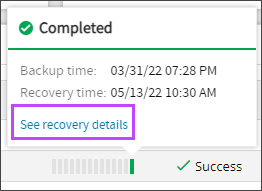Monitor Standby Image Devices
From the Management Console, you can view the dedicated Standby Image overview by selecting Recovery Dashboard > Standby Image from the vertical menu on the left hand side.
This page will list devices assigned to the Self-Hosted Standby Image plan and the Standby Image to Azure plan.
From this dashboard, you will see a specified set of columns detailing information relevant to devices using the Standby Image plan, including the continuity history of the last 14 recoveries, the status, and plan, along with some other information.
If no devices are assigned to the Standby Image plan, the dashboard will display a message to advise, along with a button to add devices to the plan.
Recovery Progress
From the Standby Image overview, the Recovery Progress column can be added, which will allow you to see the progress of the recovery as a percentage.
This column can be added by:
- Selecting Columns
- Search for and select Recovery Progress
- Click Save
Host Availability
Within the Standby Image overview, the Host Availability column can be added, which will show the availability of the recovery location host.
The column can have one of two responses:
- Offline
- Online
Searching
Searching within the Standby Image overview can be done by using the search box over to the right hand side of the page, just above the devices list. The search can be performed by any text field.
Filtering
The Standby Image overview also includes functionality to filter devices using the filter menu to the left of the device list and can be displayed or hidden by clicking the double arrows.
From this menu, you can filter by:
Recovery status
- Failed - The recovery session has failed
- Invalidated - Device was moved to an inappropriate partner and so the session has failed
- Unresponsive - The recovery session was initiated but did not receive updates for at least 30 minutes because the recovery location restarted or was offline.
- Completed with errors - The recovery session completed, but encountered errors
- Completed - The recovery session completed with no errors
- In process - The recovery is currently in progress
- Scheduled - Devices just added to a recovery plan and are waiting for their first recovery session or devices where restores were paused and have since been resumed will display as scheduled
- Retrying - A restore session was not finished so the system is trying the restore again
Recovery data sources
- Exchange
- Files and Folders
- MS SQL
- SharePoint
- System State
Recovery session statistics
- Boot Status
- Success
- Failed
- Duration of the last completed recovery session
- Sliding scale from 0 to unlimited
- Number of errors of the last completed recovery session
- Sliding scale from 0 to unlimited
- Number of restored files
- Sliding scale from 0 to unlimited
- Number of selected files
- Sliding scale from 0 to unlimited
- Restored size
- Sliding scale from 0 to unlimited
- Screenshot
- Available
- Not Available
- Selected size
- Sliding scale from 0 to unlimited
- Recovery testing status of the last completed recovery session
- Failed
- Completed with errors
- Completed
- Timestamp of the last completed recovery session
- Quick Picks of:
- Last day
- 1 - 7 days
- 7 - 14 days
- 14 - 28 days
- > 28 days
- Custom range, select a stat date and time and an end date and time
- Quick Picks of:
Widgets
Three widgets can be maximized at the top of the page, which allow for further filtering:
Device recovery status
This widget allows you to filter the devices by recovery status:
- Completed
- Completed with errors
- Failed
- In process
- Retrying
- Scheduled
VDR checks time frame
This widget allows you to see the percentage of devices whose recovery check completed within the following day ranges:
- < 1 day
- 1 - 7 days
- 7 - 14 days
- 14 - 28 days
- > 28 days
- No checks
Device restore time frame
From this widget, you can filter devices by the how recent restores are done by the following time frames:
- < 4 hours
- 4 - 12 hours
- 12 - 24 hours
- > 24 hours
- No restores
Exporting
You may export a list of devices currently assigned a plan by clicking Export
This will then provide a separate dialog where you can choose to export in either XSLX or CSV.
Manage Table Columns
Management Console allows you to manage the tables columns that can be seen within the Standby Image overview.
In the Manage table columns dialog, you can select and deselect columns based on the information you wish to view from the overview.
Pause Standby Image recovery
Once a Standby plan has been assigned to a device, the continuous restores can be paused and restarted. Pause or resume restores functionality there to provide a possibility to use the restored machine for failover in case of disaster.
If a restored Virtual Machine is turned on manually, the Standby Image restore will automatically pause.
Pausing and restarting continuous restores can done be for single or multiple devices at a time. Once devices have been paused, a banner will be displayed at the top of the page to advise.
Click See devices to filter the devices list by Continuous Restore: Paused to only devices which are currently paused.
For single devices
- Log in to the Management Console under a SuperUser or Manager account
- Navigate to Recovery Dashboard > Standby Image
- Click the menu action button to the right of the device (Three vertical dots)
- Select Pause Restores or Resume Restores
This will differ depending on whether the plan is currently active, or has been paused already
It is also possible to pause restores from the Device Properties window:
For single or multiple devices
- Log in to the Management Console under a SuperUser or Manager account
- Navigate to Recovery Dashboard > Standby Image
- Tick the checkbox for any devices that need paused from the list
- In the top panel, select Pause Restores or Resume Restores
This will differ depending on whether the plan is currently active, or has been paused already
Accessing device properties
The Device Properties window displays several tabs detailing information on the Backup device. Full details of the contents of each tab can be found on the Device management in Management Console page.
The two that are the most commonly used with Standby Image are the Settings tab and the Standby Image Verification tab.
Settings Tab
Broken into several sections, this tab contains:
General
This section provides the main device details:
- customer - Who device belongs to, can be changed to move the device to a different customer
- Device name - Cannot be changed
- Installation key - Cannot be changed
- Creation date - Cannot be changed
- Expires on - Can be amended to a date in the future, or set to 'no expiration' if required
You may also see the Request Passphrase button here if the device is set up to use this instead of its own security code/encryption key
Backup
This section contains:
- Backup product - Use the dropdown to change the Product used by the device
- Profile - Use the dropdown to change the Profile applied to the device
Recovery
On a device assigned to the Standby Image plan, this section will allow you to see plan in use and amend some details of this:
- Recovery Plan - Standby Image (Each backup session)
- Recovery Location - Cannot be changed from this panel. To change this, see Add Device to Recovery Location
- Recovery Report Email - Specify the email address that will receive reports on the status of the most recent Recovery as per the assigned plan
- Restore format - This is a choice between Hyper-V or Local VHDX
Further settings displayed are dependent on the Restore Format selected for the device. These settings can be changed as required.
Standby Image Verification Tab
To view statistics of the Standby Image and check the screenshots to ensure this has been successful, you can view this by following one of the below methods:
From Device Properties
- Log in to the Management Console
- Click the device name on either the Backup Dashboard or the Standby Image overview to open the Device Properties
- Navigate to the Standby Image Verification tab
From Standby Image Overview
The Standby Image Verification tab can be viewed from the Standby Image overview in one of two ways:
- Via theScreenshot column
- Via the Last 14 recoveries column
Screenshot column
- Log in to the Management Console
- Navigate to Recovery Dashboard > Standby Image
- Click View under the Screenshot column
- This will take you in to the Device Properties dialogue, where you will now see the Standby Image Verification tab:
Last 14 recoveries column
- Log in to the Management Console
- Navigate to Recovery Dashboard > Standby Image
- Hover your mouse over the most recent colored bar in the Last 14 recoveries column
- Click See recovery details in the popup box that appears
- This will take you in to the Device Properties dialogue, where you will now see the Standby Image Verification tab:




